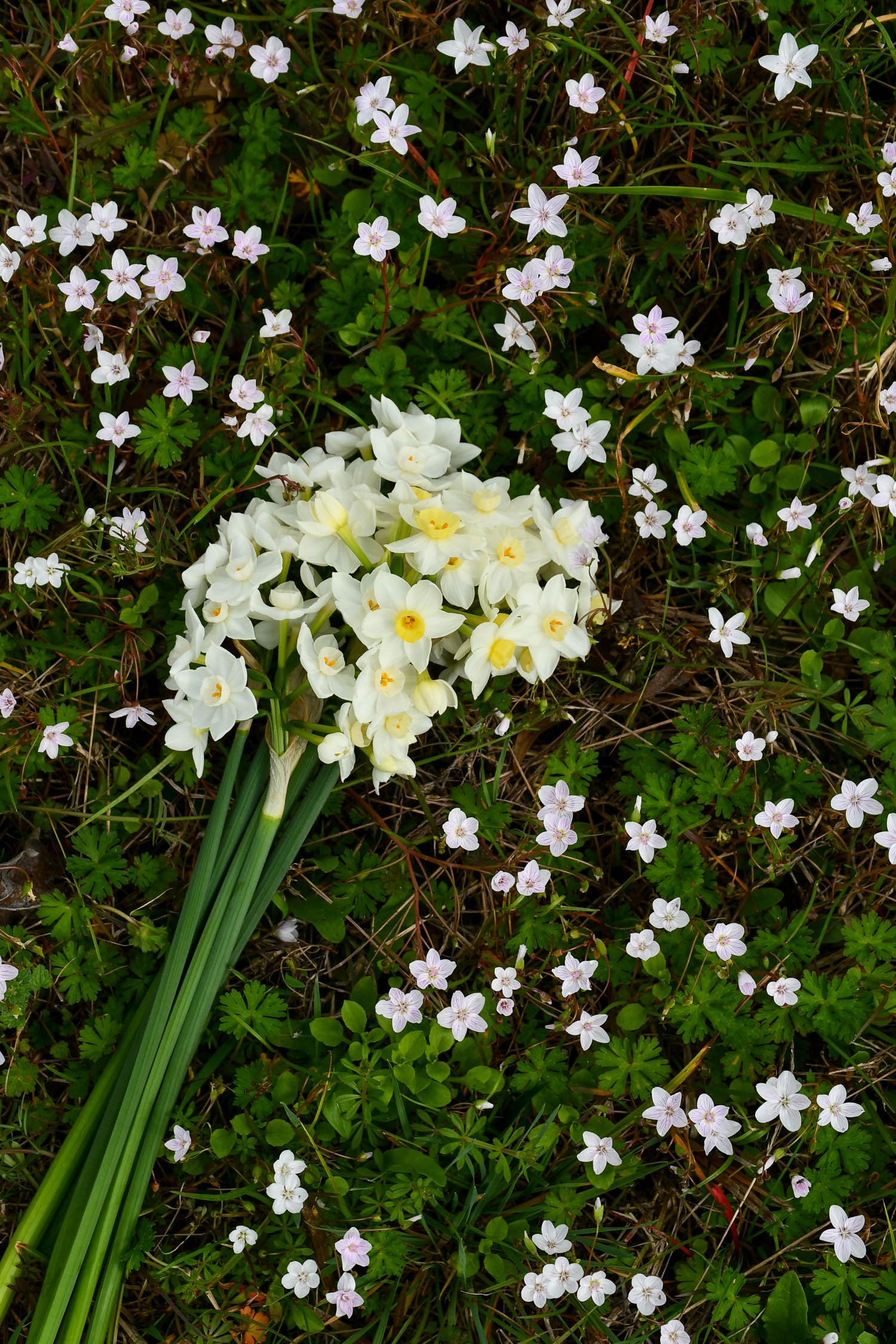It probably looks odd, me standing in front of a peach tree holding out a handful of Narcissus blooms as if I’m waiting for a branch to grasp them from my hand. But, today the petals have become paint chips as I’m deciding where I can incorporate daffodils to my plantings.
Narcissus are in full bloom here, and it is so good to see their cheerful flowers dotting the landscape. Most of them like Narcissus tazetta (tazetta daffodil), Narcissus pseudonarcissus (Lent lily), and Narcissus × odorus (campernelle) I have in holding beds where they have been bulking up over the past few years while I decide their final destination. It can be hard to determine color from a catalog photograph; therefore, I like to have the flower in hand when I’m walking around creating color combinations and deciding where they should be placed.
Some may ask why not use more modern hybrids, but in east Texas we lack the winter chill our friends further north have. Thus, I find myself turning more to species types or old heirlooms that are proven to bloom reliably in the deep south. There is opportunity in constraints, and the goal is to pair what I have plenty of with where they will look the best.
I used the same approach last year with Narcissus pseudonarcissus (top image) that are now in beds near the house where the soft buttery yellow contrasts well with emerging Phlox pilosa (downy phlox), Glandularia canadensis (rose vervain), and Muscari neglectum (starch grape hyacinth). I relocated them from a holding spot once I realized they would combine well with the plants in this bed and provide a nice pop of color. After bloom their foliage lasts for a bit as other species around them emerge, and the glaucous blades echo well the color in the nearby leaves of Rudbeckia maxima (giant coneflower) and Eryngium yuccifolium (rattlesnake master).
But, in my hand are Narcissus tazetta, and I have been pondering for a fortnight about putting them into the orchard beds that span between fruit trees. The petals are white, and the corona starts a warm yellow and then fades to cream. I confirm that the color does look good with the peach blossoms. I have tried saturated yellow Narcissus in this spot in the past, but they didn’t look right with the abundance of the soft pink in the naturally-occurring Claytonia virginica (spring beauty). So, I place the posy on the ground and become satisfied that these two pair well also.
With the clump back in hand, I walk over to Andropogon virginicus (broomsedge). I’ve been propagating them in the orchard beds. Yes, I know they seed around, but they are one of my favorite native grasses. They remind remind me of my childhood days in Tennessee. In the winter months, I love their russet orange color and how rigid they stand even in a strong north wind. I check that the tazettas pair well with them, too. The grass really accentuates the bulb’s orange stamens.
In this moment I realize that with the Narcissus I’m straddling the pastel side of the warm spectrum with tints of pinks, tangerines, and butters. I feel content that I’ve considered all possibilities with my petal paint chips and decide that this area would make a good spot for this daffodil. Perhaps a random scattering through the orchard beds, clustered densely in groups and then fading out to singles, much like bulbs arrange themselves in nature. And, I won’t cut the grass back until the daffodils are finished flowering to further play off the color echo.
Narcissus tazetta and Prunus persica
Narcissus tazetta and Andropogon virginicus
Narcissus tazetta and Claytonia virginica
Next, I consider the Narcissus × odorus that I’ve been hoarding for years in a bed in the back of the patch. I’ve found the perfect place for them. It’s a bit easier since it is now a mostly blank slate. East of our house is a glade that is now more open since we had two live oaks cut that suffered greatly from the -6°F freeze in 2021. There is a large Magnolia ‘Susan’ in this space. It is here the campernelles will go. Both have very saturated petals, and I have the goal of adding more short statured Magnolias to this area to continue playing off the spring colors. And, yes, I do check to make sure their colors go well together, too.
Narcissus × odorus and Magnolia ‘Susan’
I’ll start moving the Narcissus after they finish blooming. I don’t have issues relocating Narcissus in the green. I just make sure that they get watered in well after I plant them. Often I’ll choose a day or two right before a good rain comes for relocation.
When placing Narcissus, I just have to remember that they don’t always look this way, and that after they bloom, I’ll have the foliage to look at or deal with over the next three months until it either fades away or is trimmed around Mother’s Day. The delayed cut back ensures the bulbs can store enough sugars for more handfuls of blooms next year.




